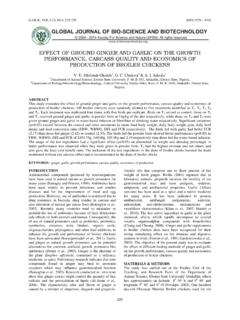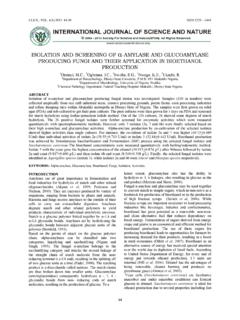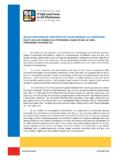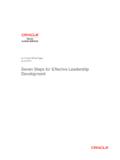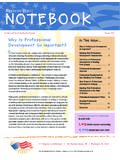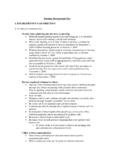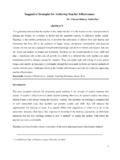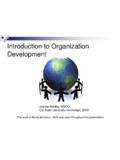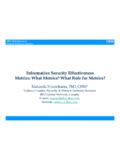Transcription of TRAINING AND DEVELOPMENT PRACTICES IN AN …
1 , (4) 2011:187-198 ISSN 2229 -600X187 TRAINING AND DEVELOPMENT PRACTICES IN AN ORGANISATION: ANINTERVENTION TO ENHANCE ORGANISATIONAL EFFECTIVENESS1 Henry Ongori,2 Jennifer Chishamiso NzonzoUniversity of Botswana, Faculty of Business, Department of Management,Corner Mobutu / Notwane Road, Gaborone, P/Bag UB00701, BotswanaABSTRACTT raining and DEVELOPMENT of employees is critical in organisations in this era of competition due to the fact thatorganizations need to survive, grow and develop. Consequentially, TRAINING and DEVELOPMENT has become an issue ofstrategic importance. Although many scholars have conducted research on TRAINING and DEVELOPMENT PRACTICES inorganisations in both developing and developed economies, it is worth mentioning that most of the research hasconcentrated on the benefits of TRAINING in general.
2 There is however, limited focus on evaluation of TRAINING anddevelopment PRACTICES in organizations and yet, TRAINING and DEVELOPMENT of employees is critical for the survival andgrowth of any entity. To fill this gap, this study critically examines in detail the benefits, approaches and evaluationtechniques applied in TRAINING and DEVELOPMENT of employees in an organisation. The methodology adopted for thisstudy was random samplings where 61 managers of eight organisations were selected for the study. The major findingof the study indicated that TRAINING and DEVELOPMENT of employees increases organisational effectiveness and enhancescompetitiveness. The limitation of the study is that sample size selected for the study comprised of organisation inGaborone city and its surrounding areas.
3 The contribution of this study is that it provokes insights amongst owners /managers, policy makers and scholars on how organisation TRAINING and DEVELOPMENT PRACTICES could be enhanced inorder to improve organisational effectiveness and retain human Organisation, TRAINING , DEVELOPMENT , Human Capital and BotswanaINTRODUCTIONT raining is considered as the process of upgrading theknowledge, developing skills, bringing about attitude andbehavioural changes, and improving the ability of thetrainee to perform tasks effectively and efficiently inorganisations (Wills, 1994; Palo et al, 2003; Robert et al,2004). Similarly, Stewart (1996) combines the twoconcepts of TRAINING and DEVELOPMENT and gives anorganisation function which has the outcome of ensuringthat the contribution of individuals and groups inachieving the organisational objectives through thedevelopment of appropriate knowledge, skills andattitude of the employees.
4 The contribution andimprovement of organisation performance is primarilythrough DEVELOPMENT of people as individuals, workgroups and as members of the wider , TRAINING and DEVELOPMENT of employees is asystematic process that intends to ensure that theorganisation has effective employees to meet theexigencies of its dynamic environment. This is inclusiveof adding to the employee knowledge, skills and attitudesrequired by an individual to improve his performance inthe organisation. Although the use of managementinventories, replacement charts, company tours for newlyrecruited graduates, job rotation programmes and endlessseries of formal courses have typified TRAINING anddevelopment as a mechanical process. It should be notedthat organizations have begun to realize that it is notadequate to leave everything to chance and naturalselection and trial and error hence, the proliferation oftraining and DEVELOPMENT in purpose of this study was to find out howtraining and DEVELOPMENT PRACTICES are used as one of thestrategies of enhancing organisational effectiveness .
5 Inaddition, the study also focuses on the role of trainingemployees, methods used in TRAINING employees andevaluation of TRAINING programs. This paper is dividedinto four section 1 deals with the introduction andliterature review. Section II, deals with methodologyadopted for the study, section III, deals with the resultsand discussion and finally section IV highlights theconclusions and implications of the study. The study wasconducted to the answer the following is the role of TRAINING and DEVELOPMENT onemployees within an organisation? are the various methods used in the trainingand DEVELOPMENT of employees? are TRAINING programs evaluated within anorganisation? TRAINING and DEVELOPMENT PRACTICES in an Organisation: An Intervention to Enhance Organisational Effectiveness188 LITERATURE REVIEWROLE OF TRAINING AND DEVELOPMENT OFEMPLOYEESF ormal TRAINING programmes are an effective way ofdirectly transferring the organisational goals and valuesto a whole group of people simultaneously (Shen, 2006;Harzing, 2004).
6 Appropriate TRAINING can developmanagers at all levels including the knowledge and skillsrequired to gain competency in order to manage changein organisation in any business environment (Stewart,1996; John, 2000).) In multinational companies, trainingcan provide an important impetus to achieve sharedvalues and facilitates network building betweenheadquarters and subsidiaries. Helliriegel et al,(2001)states that TRAINING of employees in organisationincreases higher productivity through better jobperformance, more efficient use of human resources,goals and objectives more effectively met, reduced costdue to less labour turnover, reduced errors, reducedaccidents and absenteeism, more capable, and mobileworkforce and retention of the existing staff.
7 Similarly,Echard and Berge (2008) stated that effective trainingtechniques can produce significant business resultsespecially in customer service, product DEVELOPMENT , andcapability in obtaining new skill set. This linkage oftraining to business strategy has given many businessesthe needed competitive edge in today s global and Berge, (2008) also provides that effectivetraining and DEVELOPMENT improves the culture of qualityin business, workforce, and ultimately the final product(Huang, 2001)..an educated and well trained workforceis considered to be essential to the maintenance of abusiness firm s competitive advantage in a Resource Management (HRM) PRACTICES oftraining and DEVELOPMENT enhance employee skills,knowledge and ability which in turn enhance taskperformance of individual and in the long run increasesthe organisational productivity (Huselid 1995).
8 However,Wood, (1999) argues that HRM PRACTICES are universalacross organisations or whether the effectiveness ofhuman resources management is contingent upon factorswhile (Asgarkhani, 2003) argues that the success oftraining is contingent upon the effectiveness ofperformance planning and measuring. The fact of thematter is that the three fundamental aspects surroundingthis approach are process classification, selection ofproposed methods, and delivery. We could go further andconsider Shandratilek (1997) and Dessler 2005 whoemphasized that the point that the availability of highquality employees, places the organisation in acompetitive advantage over others even within the sameindustry and that the inadequacy of expertise is a majorconstraint as such organisation take major concretemeasures to organize TRAINING programmes.
9 The resultanteffects of properly executed TRAINING programmes arereflected through the performance management is the integrated process employers use to make sureemployees are moving towards organisational performance management to approach trainingmeans that the TRAINING effort must make sense in termsof what the company makes each employee to contributeto achieving the company s does bear fruitful results not only to theorganisation but also to the employees. TRAINING is anopportunity for promotion and self improvement,improved job satisfaction through better jobperformance, a chance to learn new things and there isgreater ability to adapt and cope with changes (John etal, 2002). This is supported by (Bhalla, 2006) whoargued that the objective of any organisation trainingprogram is to train their employees to meet the needs ofthe optimum profit potential.
10 In addition, Hower (2008)pointed out that the purpose of TRAINING is to empowerassociates with the skills necessary to make decisionsand accomplish their daily tasks and skills that help themgive extraordinary service to customers. In the businessof customer service, TRAINING is essential to the impactmade on the customers. Customer service and problemresolution are trainable skills and will determine whetherthe customer impact is positive or negative. It alsoprepares employees for their next career move. Thismove may be in the organisations or in life in and Pareek (2000) argue that to enhanceindividual motivation for TRAINING , the employees shouldbe part and parcel of what it communicates to applicantsthrough all its contacts with them. This would makeapplicants feel confident that the TRAINING foci are clearand shows perceptive concern for people taking part inthe program.
